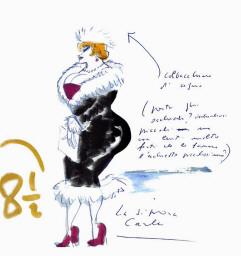A valuable and little-known collection of sketches by legendary Italian film director Federico Fellini is now on show in the northern town of Adro.
The pictures are on loan from a collection that once belonged to one of Fellini's closest aides and collaborators, Liliana Betti.
Betti, who was born in Adro, worked with the director for over two decades.
Unlike drawings produced by other filmmakers, who used sketching as a way to clarify their ideas about the set and the development of the film, Fellini turned to art for escapism and fantasy.
He started drawing as a boy in Rimini, producing caricatures of Hollywood stars in exchange for free entry into his local cinema.
As a young man, he turned this knack to comic drawings and cartoons, which he sold to different newspapers.
This eventually led to him working as a journalist, scriptwriter and film director. But his love of drawing and caricature lingered in a life-long passion for cartoons and doodling.
While other exhibitions have explored this side of Fellini's talent, the pieces on display in Adro are from a rarely shown private collection.
Divided into three sections, the first part features a series of sketches of Betti herself, who started as a general aide and eventually became Fellini's personal assistant.
Betti, who later enjoyed a very successful career as a film and TV scriptwriter, was also Fellini's assistant director on several films.
The second and third parts of the exhibit turn from the realistic to the imaginary.
Entitled ''Fantasy Between One Take and Another'' and ''Masks of the Grotesque'', they offer an insight into Fellini's imagination, subconscious, thoughts and ideas.
They include a large number of erotic drawings, with oversized male genitalia, but all characterized by the dreamy, fantastical atmosphere that was the hallmark of many Fellini films.
The exhibition also features a behind-the-scenes documentary made by Betti about Fellini's cult hit Amarcord, for which he won the 1973 Oscar for best foreign film.
The exhibition remains on show in the Palazzo Bargnani Dandolo until October 19, after which it moves to the Filodrammatici Theatre in Milan.








